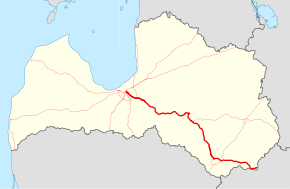A6 road (Latvia)
The A6 is a national road in Latvia, connecting Riga to the Belarusian border at Pāternieki. It bypasses Daugavpils in its north and passes through Krāslava and is also known as the Daugavpils Highway in Latvia.
| ||||
|---|---|---|---|---|
| Daugavpils šoseja | ||||
 | ||||
| Route information | ||||
| Part of | ||||
| Length | 307 km (191 mi) | |||
| Major junctions | ||||
| From | Riga | |||
| To | ||||
| Highway system | ||||
National Roads in Latvia
| ||||
The road is part of European route E22, European route E262 and the Latvian TEN-T road network. Once inside Belarus, the road becomes the Belarusian P20. The length of the A6 in Latvian territory is 307 kilometres (191 mi). Currently the A6 has two lanes in each direction between Riga and Ogre and between Nīcgale and Daugavpils, with other parts having just a single carriageway. The current speed limit in winter is 90 kilometres per hour (56 mph), but in summer the dual carriageway parts are raised to 100 kilometres per hour (62 mph).
Since 2013 a shorter route has replaced the Salaspils-Koknese section of A6 (numbered as P80), mainly built for transit traffic. The construction of it was first started in the 1980s, but the plan was abandoned later. The first stage of the construction starts in Tīnuži and ends in Koknese. It was planned to be complete by 2012, but due to economical reasons the works were delayed and were finished in 2013. Between 2020 and 2027 the authorities plan to bring the new road into Riga. It would also have 2x2 lanes with an expressway/motorway status. There are also plans to continue the new road parallel to the A6 as far as Pļaviņas. The annual average daily traffic of the A6 in 2016 was 8,054 vehicles.
Crossings
| # | Road name | Location |
|---|---|---|
| 1 | A5 | Salaspils |
| 2 | A4 | Salaspils |
| 3 | P10 | Ikšķile |
| 4 | P10 | Inčukalns |
| 5 | P8 | Ķegums |
| 6 | P32 | Skrīveri |
| 7 | P87 | Aizkraukle |
| 8 | P80 | Koknese |
| 9 | P79 | Koknese |
| 10 | P78 | Pļaviņas |
| 11 | P37 | Pļaviņas |
| 12 | A12 | Jēkabpils |
| 13 | P63 | Līvāni |
| 14 | P64 | Nīcgale |
| 15 | A14 | Daugavpils |
| 16 | A13 | Daugavpils |
| 17 | P65 | Daugavpils |
Major cities crossed
Gallery
 Daugavpils bypass on A6, 2009.
Daugavpils bypass on A6, 2009. A6 in Riga, 2010
A6 in Riga, 2010 A6 from bird's view over Ciemupe, 2010.
A6 from bird's view over Ciemupe, 2010. A6 near Jersika, 2010.
A6 near Jersika, 2010.
